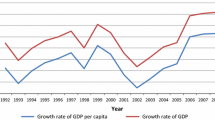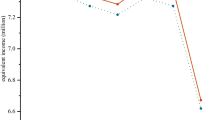Abstract
This paper fills the existing knowledge gap by examining the changes in the extent and nature of child poverty in urban China between 1989 and 2011, and contributes to the literature by using the relative income approach, different from the absolute income approach used in many previous studies. All waves of the China Health and Nutrition Survey Data (CHNS) is used including the newest 2011 survey. Both the anchored and current relative poverty lines were constructed in this paper. In addition, the FGT index introduced by Foster et al. (Econometrica 52(3), 761–766, 1984) is used to measure income poverty gaps and inequalities. The findings show that income distribution has been unequal and the income gap has widened during the study period. Although China has achieved great economic growth since economic reform, the lower income group benefited much less from China's fast economic growth compared with the middle or higher income groups. The findings of this paper imply that policy makers need to pay more attention in future on reducing income inequality in urban China.







Similar content being viewed by others
Notes
The NBS provide urban residents’ Consumer Price Index (CPI), which is used as a deflator to adjust the anchored poverty lines. The official CPI calculated by the National Bureau Statistics (http://www.stats.gov.cn) includes 262 categories of commodities and prices of services, which are summarised into eight groups: food, clothes, alcohol and cigarettes, health, shelter, transport and communications, entertainment, education and cultural goods and services, household consumer durables and services.
Table 1 shows that the anchored poverty line in 1989 is 1251 yuan while 50 % median current poverty line is 1196 yuan. These two poverty lines are slightly different, and this is because not totally overlapping of the two variables, i.e., hhinc_cp and hhinc used in the estimations of these two poverty lines. The household income variable used for setting the median poverty lines in the CHNS data is hhinc_cp, i.e., the median poverty lines. For estimating the anchored line, the variable used in the CHNS dataset is hhinc (total net hh income without adjustment using cpi).
References
Appleton, S., & Song, L. (2008). The myth of the “new urban poverty”? trends in urban poverty in China, 1988–2002. In J. R. Logan (Ed.), Urban China in transition (pp. 48–65). UK: Blackwell Publishing Ltd.
Appleton, S., Song, L., & Xia, Q. (2010). Growing out of poverty: trends and patterns of urban poverty in China 1988–2002. World Development, 38(5), 665–678.
Atkinson, T., Cantillon, B., Marlier, E. & Nolan, B. (2002). Social indicators-the EU and social inclusion Oxford University Press.
Bosker, M., Brakman, S., Garretsen, H., & Schramm, M. (2012). Relaxing Hukou: increased labor mobility and China’s economic geography. Journal of Urban Economics, 72(2–3), 252–266.
Boyden, J., & Dercon, S. (2012). Child development and economic development: lessons and future challenges. Oxford: Young Lives.
Bradbury, B., & Jantti, M. (2001a). Child poverty across the industrialised world: evidence from the Luxembourg income study. In K. Vleminckx & T. Smeeding (Eds.), Child well-being, child poverty and child policy in modern nations. Bristol: The Policy Press.
Bradbury, B. & Jantti, M. (2001b) Child poverty across twenty-five countries. In Bradbury, B., Jenkins, S. P. & Micklewright, J. (eds), The dynamics of child poverty in industrialised countries. Cambridge University Press.
CDRF (The China Development Research Foundation)(2009) Eliminating poverty through development in China. London: Routledge.
Chen, Y., & Feng, S. (2013). Access to public schools and the education of migrant children in China. China Economic Review, 26, 75–88.
Cheng, Z., & Wang, H. (2013). Do neighbourhoods have effects on wages? A study of migrant workers in urban China. Habitat International, 38, 222–231.
Cheng, Z., Nielsen, I., & Smyth, R. (2014). Access to social insurance in urban China: a comparative study of rural–urban and urban–urban migrants in beijing. Habitat International, 41, 243–252.
CoP (2013). Hong Kong poverty situation report 2012. Hong Kong: government of the Hong Kong Special Administrative Region.
Eurostat (2002) European social statistics: Income poverty and social exclusion. Luxembourg: Office for Official Publications of the European Communities.
Fang, C., Zhang, X., & Fan, S. (2002). Emergence of urban poverty and inequality in China: evidence from household survey. China Economic Review, 13(4), 430–443.
Foster, J., Greer, J., & Thorbecke, E. (1984). A class of decomposable poverty measures. Econometrica, 52(3), 761–766.
Gustafsson, B., & Sai, D. (2009). Rank, income and income inequality in urban China. China Economic Review, 20(3), 497–507.
Gustafsson, B., Li, S., & Sicular, T. (2008). Inequality and public policy in China. Cambridge: Cambridge University Press.
Jiang, M. (2009). A study on urban children poverty phenomenon: The deprivation of child rights and basic needs---The case of Tianjin, China. Ph.D. The Chinese University of Hong Kong (Hong Kong). Available online: http://easyaccess.lib.cuhk.edu.hk/login?url=http://search.proquest.com/docview/305157605?accountid=10371.
Khan, A. R., & Riskin, C. (2001). Inequality and poverty in china in the Age of globalization. New York: Oxford University Press.
Lai, F., Liu, C., Luo, R., Zhang, L., Ma, X., Bai, Y., Sharbono, B., & Rozelle, S. (2014). The education of China’s migrant children: the missing link in China’s education system. International Journal of Educational Development, 37, 68–77.
Li, W. (2013). “Hukou” status, place affiliation and identity formation: the case of migrant workers in Metropolitan Beijing. Procedia Environmental Sciences, 17, 842–851.
Li, L., Li, S., & Chen, Y. (2010). Better city, better life, but for whom?: the Hukou and resident card system and the consequential citizenship stratification in Shanghai. City, Culture and Society, 1(3), 145–154.
Liu, Z., Wang, Y., & Tao, R. (2013). Social capital and migrant housing experiences in Urban China: a structural equation modeling analysis. Housing Studies, 28(8), 1155–1174.
Lu, A., & Wei, Z. (2002). Child poverty and wellbeing in China in the era of economic reforms and external opening. In G. A. Gornia (Ed.), Harnessing globalization for children: a report to UNICEF. Florence: UNICEF Innocenti Research Centre.
Marlier, E., Atkinson, A. B., Cantillon, B., & Nolan, B. (2007). The EU and social inclusion-facing the challenges. Bristol: The Policy Press.
Meng, X., Gregory, R., & Wang, Y. (2005). Poverty, inequality, and growth in urban China, 1986–2000. Journal of Comparative Economics, 33(4), 710–729.
Menton, C. (2007). An investigation of the measurement of poverty in Ireland. Ireland: Institute of Public Administration.
Morrison, W.M. (2014). China’s economic rise: History, trends, challenges, and implications for the United States. Available online: [Accessed.
NBS. (2012). China statistical yearbook 2012. Beijing: China Statistics Press.
NBS-PES (2012). China population and employment statistics yearbook 2012. China Statistics Press.
NBS-USE (1990). 1990 China urban life and price yearbook. Beijing.
NBS-USE (2000). 2000 China urban life and price yearbook Beijing.
NBS-USE (2011). 2011 China urban life and price yearbook. Beijing.
Notten, G., & De Neubourg, C. (2011). Monitoring absolute and relative poverty: not enough is not the same as much less. The Review of Income and Wealth, 57(2), 247–269.
OECD (2009) What are equivalence scales?. Available online: http://www.oecd.org/eco/growth/OECD-Note-EquivalenceScales.pdf.
Park, A., & Wang, D. (2010). Migration and urban poverty and inequality in China. China Economic Journal, 3(1), 49–67.
Peng, Z., & Ding, Y. (2012). Tacking urban poverty in China: the minimum living standard Sheme and its limitations. Journal of Poverty and Social Justice, 20(3), 261–276.
Qi, D., & Tang, V. M. Y. (2015). Social assistance programs and child poverty alleviation- a comparison between Hong Kong and mainland China. Asian Social Work and Policy Review, 9, 29–44.
Qi, D., & Wu, Y. C. (2014). Child poverty in China- a multidimensional deprivation approach. Child Indicators Research, 7(1), 89–118.
Qi, D., & Wu, Y. (2015). A multidimensional child poverty index in China. Children and Youth Services Review, 57, 159–170.
Ravallion, M. (1998). Poverty lines in theory and practice, 133. Washington, D.C.: World Bank.
Ravallion, M., & Bidani, B. (1994). How robust is a poverty profile? The World Bank Economic Review, 8, 75–102.
Solinger, D. J. (2011). Dibaohu in distress- The meagre minimum livelihood guarantee system in Wuhan. In J. Duckett & B. Carrillo (Eds.), China’s changing welfare mix-local perspectives. London: Routledge.
Song, Y. (2014). What should economists know about the current Chinese hukou system? China Economic Review, 29, 200–212.
Townsend, P. (1962). The meaning of poverty. The British Journal of Sociology, 13(3), 210–227.
Townsend, P. (1979). Poverty in the United Kingdom. London: Allen Lane and Penguin Books.
UNDP (2004). Children and poverty. In Focus. Available online: http://www.ipc-undp.org/pub/IPCPovertyInFocus2.pdf.
UNICEF. (2005a). Child poverty in rich nations. Florence: UNICEF Innocenti Research Centre.
UNICEF. (2005b). The State of the World’s children 2005-children under threat. New York: The United Nations Children’s Fund (UNICEF).
UNICEF. (2012a). Measuring child poverty, New League tables of child poverty in the world’s rich countries. Florence: UNICEF Innocenti Research Centre.
UNICEF (2012). The State of the World’s Children 2012-Children in an Urban World. New York: The United Nations Children’s Fund (UNICEF)
Wu, F. (2010). Urban poverty in China. Cheltenham, UK; Northampton, MA: Edward Elgar.
Wu, L. (2013). Decentralization and hukou reforms in China. Policy and Society, 32(1), 33–42.
Xiong, J., Hipgrave, D., Myklebust, K., Guo, S., Scherpbier, R. W., Tong, X., Yao, L., & Moran, A. E. (2013). Child health security in China: a survey of child health insurance coverage in diverse areas of the country. Social Science & Medicine, 97, 15–19.
Xue, J., & Zhong, W. (2003). Unemployment, poverty and income disparity in urban China. Asian Economic Journal, 17(4), 383–405.
Zhang, H. (2010). The Hukou system’s constraints on migrant workers’ job mobility in Chinese cities. China Economic Review, 21(1), 51–64.
Acknowledgements
This research uses data from China Health and Nutrition Survey (CHNS). We thank the National Institute of Nutrition and Food Safety, Chinese Centre for Disease Control and Prevention, Carolina Population Centre, the University of North Carolina at Chapel Hill, the NIH (R01-HD30880, DK056350, and R01-HD38700) and the Fogarty International Centre, NIH for financial support for the CHNS data collection and analysis files since 1989 and both parties plus the China-Japan Friendship Hospital, Ministry of Health for support for CHNS 2009. The authors are also grateful to two referees for their helpful comments on the earlier versions of this paper.
Author information
Authors and Affiliations
Corresponding author
Appendix
Appendix
Rights and permissions
About this article
Cite this article
Qi, D., Wu, Y. Child Income Poverty Levels and Trends in Urban China from 1989 to 2011. Child Ind Res 9, 1043–1058 (2016). https://doi.org/10.1007/s12187-015-9351-1
Accepted:
Published:
Issue Date:
DOI: https://doi.org/10.1007/s12187-015-9351-1




